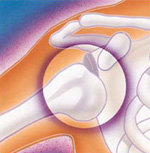Dislocated Shoulder Education
Omaha Shoulder Anatomy Information by Dr. Darren Keiser
Anatomy
 How does a person get a Dislocated Shoulder? Shoulder Dislocation has many causes, symptoms, treatment and rehabilitation options. The shoulder joint is the body’s most mobile joint. It can turn in many directions. But, this advantage also makes the shoulder an easy joint to dislocate.
How does a person get a Dislocated Shoulder? Shoulder Dislocation has many causes, symptoms, treatment and rehabilitation options. The shoulder joint is the body’s most mobile joint. It can turn in many directions. But, this advantage also makes the shoulder an easy joint to dislocate.
A partial dislocation (subluxation) means the head of the upper arm bone (humerus) is partially out of the socket (Glenoid). A complete dislocation means it is all the way out of the socket. Both partial and complete dislocation cause pain and unsteadiness in the shoulder.
Symptoms
Dislocated Shoulder Symptoms include:
> Swelling
> Numbness
> Weakness
> Bruising
Sometimes a shoulder dislocation may tear ligaments or tendons or damage nerves. The shoulder joint can dislocate forward, backward, or downward. A common type of shoulder dislocation is when the shoulder slips forward (anterior instability). This means the upper arm bone moved forward and down out of its joint. It may happen when the arm is put in a throwing position.
Diagnosis
The muscles may have spasms from the disruption, and this can make it hurt more. When the shoulder dislocates time and again, there is shoulder instability.
The doctor will examine the shoulder and may order an X-ray. It is important that the doctor know how the dislocation happened and whether the shoulder had ever been dislocated before.
Treatment
With a Dislocated Shoulder, the doctor will place the ball of the upper arm bone (humerus) back into the joint socket. This treatment process is called closed reduction. Severe pain stops almost immediately once the shoulder joint is back in place.
Rehabilitation
Your doctor may immobilize the shoulder in a sling or other device for several weeks following treatment. Plenty of rest is needed. The sore area can be iced 3 to 4 times a day.
After the pain and swelling go down, the doctor will prescribe rehabilitation exercises for you. These help restore the shoulder’s range of motion and strengthen the muscles. Rehabilitation may also help prevent dislocating the shoulder again in the future. Rehabilitation will begin with gentle muscle toning exercises. Later, weight training can be added.
If shoulder dislocation becomes a chronic condition, a brace can sometimes help. However, if therapy and bracing fail, surgery may be needed to repair or tighten the torn or stretched ligaments that help hold the joint in place, particularly in young athletes.
Shoulder information provided by Dr. Darren Keiser.
